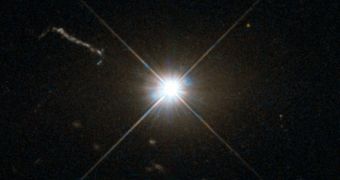Astronomers operating the NASA/ESA Hubble Space Telescope recently released an astounding new image collected with by instruments aboard the flagship observatory. The photo is centered on an objects called 3C 273, which is an extremely bright quasi-stellar radio source (quasar).
Quasars are the luminous cores of distant active galactic nuclei (AGN). Astrophysicists believe these structure may include supermassive black holes at the centers of such galaxies. The object seen in this photo lies 2.5 billion light-years away, nestled inside an elliptical galaxy in the Virgo constellation.
Astronomer Allan Sandage identified 3C 273 in the early 1960s, the first structure of its type to be described. Though located relatively fat away from our galaxy, it remains to this day one of the closest quasars we have ever discovered.
This image was collected some time ago by the Wide Field and Planetary Camera 2 instrument on Hubble. The camera was installed by astronauts on space shuttle Endeavour, in 1993, and was replaced by the Wide Field Camera 3 in 2009, during shuttle Atlantis' STS-125 mission. The WFPC2 is now exposed at the Smithsonian's National Air and Space Museum.

 14 DAY TRIAL //
14 DAY TRIAL //